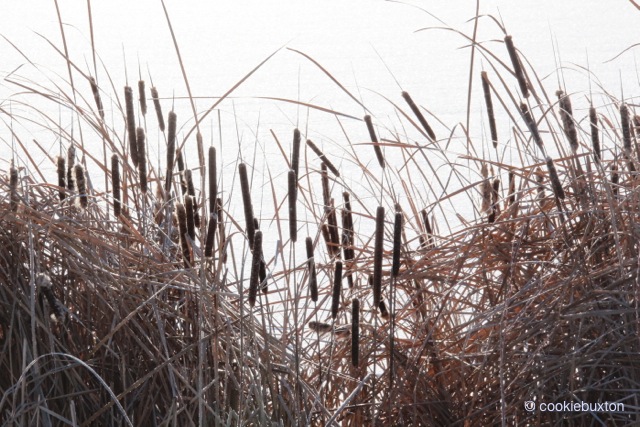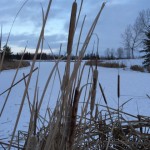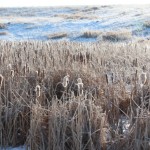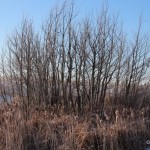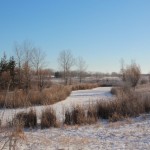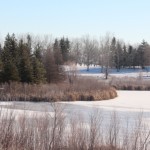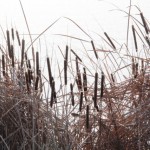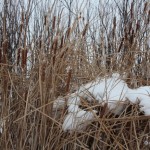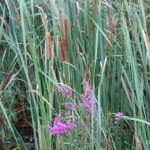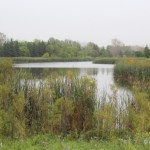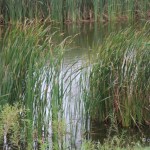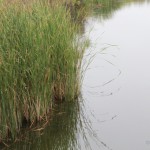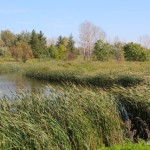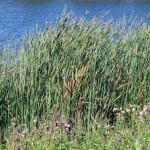Common Broadleaf Cattail, a Native Wetlands Plant
Cattails, classified into 10 species, are wetland plants found world-wide. The Common broadleaf cattail (Typha latifolia) is an important species found widely throughout and native to the Canadian prairies. Also found in the Canadian prairie region is the Narrow-leafed cattail (Typha augustifolia).
Common broadleaf cattail is found in roadside ditches and along the banks of shallow lakes, quiet streams, and throughout the wetland marshes dotting the landscape. In my area, south of Manitoba’s Netley Marsh, cattails grow abundantly in ditches and along the many feeder streams that meander through the marshes and empty into the lakes and rivers.
Childhood memories of collecting cattails
Among the iconic images of the prairies, and seared in my memory from car trips to Lake Winnipeg’s Sandy Hook cottage area as a youngster, are images of red-winged blackbirds dipping among cattails in the ditches along the highway routes north past the marsh regions and on towards the lake. Sometimes the sky at dusk would be coloured deep grey from cloud cover, and the light would break under and cast its sheen across the wheat fields and tops of the cattails. Against this prairie backdrop, these handsome birds would perch on the cattails, singing their blackbird songs, and watching the world move by.
A favourite story from years ago relates to a fine collection of cattails that I handpicked and spread out to dry on my home deck. I was living in Winnipeg’s trendy Osborne district at that time. There was a mixed age-range in the region, and some young kids lived nearby. They collected empty pop bottles and cans, which they traded in for a penny or two at the corner store. The kids were grateful that I gave them my containers, and they were steady travellers up and down my wooden steps on their collection visits.
One marvellous, warm weekend in late summer, returning home from a day at Grand Beach on Lake Winnipeg’s east side, I stopped to wade into the marshes where I spent an hour or more collecting Common cattails. My plan was to dry and display this beautiful collection over the winter months, as illustrated so beautifully in one of the decorating magazines.
I brought the cuttings home and, with great care not to scrape or break the cattail heads, meticulously laid them out across the wooden deck to dry in the evening air. I spent the next day at work, and came home to a memorable vision. The dear children of the neighbourhood, grateful for the small coin they got from my beverage containers, had decorated my porch for me as a thank-you. A widow lived nearby. They picked all of her annual pansies and marigolds, and arranged these in pairs and threes in dozens of small bouquets, which they tucked in together with the snapped-off cattail heads from my collection. They left two-inch stems below the heads, and placed these flower packets into the narrow spaces between the wooden deck slats, making a flower-strewn path up both sides of my steps and across the porch, leading to my front door. The cattails, grouped in bundles and paired with the now-wilted annuals, were displayed as handsomely as you or I could have done with all the decorating magazines in the world to guide us.
The children paid me great compliment in spending their time as they had; they were less kind to my neighbour whose garden they raided. They left me, though, with one of my most precious memories. The lesson I took from my freelance decorating squad was simply this: relax, breathe deeply, and enjoy the moment.
All parts of the Common broadleaf cattail (Typha latifolia) are edible, and the plants serve as an abundant source of nutrients for wildlife. If you are a back-country traveller, it would be sensible to learn how to harvest parts of the plant for emergency rations and as an occasional source of fresh food.
Besides being a food source, these plants provide habitat in summer for birds and smaller animals, and offer shelter in winter for deer and other wild creatures.
Cattails are especially valuable during the part of their growth cycle when they purify and clean our waterways (at other times, they release nutrients back into the water). The plants are known for their ability to pull toxins from the water; be careful not to eat plants that are grown in polluted waters.
A further note is that recent research and trends point to growing and sustainably harvesting cattails as a bio-mass fuel and potential source of “carbon credits.”
Photos and text: Nadine Kampen
Copyright: NKampen/cookiebuxton
Photo locations: Kilcona Park (winter and fall), Winnipeg
PHOTO GALLERY
Click on any photo to enlarge; click again on the photo to advance.
